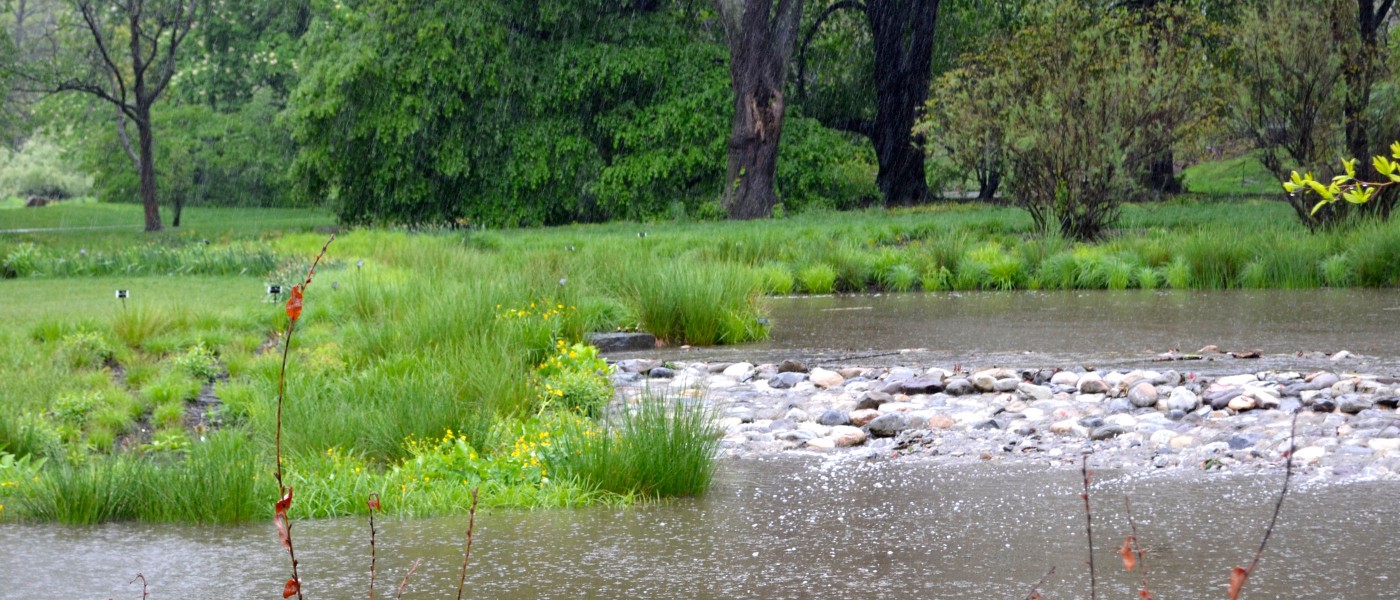Brooklyn Botanic Garden’s Guide to Rainwater Harvest
New York’s water system, like those of many old American cities, is a low-tech network of cisterns and pipes that hasn't changed much in the 150 years since it was built. In that time, the population has grown from less than half a million to 8.5 million people. Furthermore, most green space has been replaced with buildings, asphalt, and concrete, leaving very little permeable surface to soak up excess water during a storm.
Rain can overwhelm the antiquated storm drains so that they overflow into the general sewage system and force polluted water into local waterways. Some days, you can actually see raw sewage flooding into the Gowanus Canal. Other overflows aren’t as obvious at first but lead to water pollution and consequent beach closings when bacteria levels become too high.
How can you help ease this burden? As a city dweller, your options depend on the type of building you live in and the kind of garden you maintain but everyone can do something, and every drop counts.
Rain Harvesting Methods to Use in the City
-
Row House or Other Small Building
Plant a small rain garden, hook up a rain barrel, or start a container garden.
Featured Garden: A Charming Williamsburg Rain Garden and Green Roof
Learn How to Do ItIf your building has an external downspout, consider installing a rain barrel to collect runoff from the roof. The Department of Environmental Protection provides free 60-gallon rain barrels for New York City residents.
If your home includes a garden or yard, you can also create a rain garden to soak up some excess storm water. These can be small, simple depressions filled with a few well-chosen plants or a more complex design that incorporates gravel and drains beneath the soil surface to funnel away water.
There are also a few simple accommodations you can make to reduce runoff.
- Omit curbs that enclose your street-side garden strips and tree beds so that rainwater can run into them instead of out to the street and down the storm sewer.
- Set an empty ceramic or plastic pot out on your patio, roof, or terrace to catch rain. Cover it with screen to keep mosquitoes out, and use it to fill your watering can when you need to water your garden. This works particularly well as part of a container garden.
- Another nice option: a downspout planter—a container filled with water-loving plants placed beneath your downspout to slow rainwater runoff.
-
Large Apartment Building
Consider an intensive green roof system or a modest rooftop container garden. Take care of the city's curbside rain gardens on your block.
Featured Garden: A Manhattan High Rise With Two Green Roofs
Learn How to Do ItThe most comprehensive approach would be to install a green roof. Granted, retrofitting a building with a green roof will require a committed co-op board or building owner and a significant investment. But besides mitigating storm-water runoff, there are other benefits: increased energy efficiency and usable outdoor space. BBG's handbook Green Roofs and Rooftop Gardens provides an overview of extensive and intensive green roof systems.
- If you can’t commit to a full green roof system, consider a more modest rooftop container garden, or at ground level, a courtyard or patio container garden. Include among your planted pots one or more open-top, watertight vessels (sans drainage holes) to harvest even more rain. Cover them with a screen to prevent mosquito infestation, and use the rain you collect to water your plantings.
- If you have a courtyard or front yard, you can also build an in-ground rain garden. Just avoid siting it directly adjacent to your building to avoid foundation leaks.
- Most large apartment buildings have internal drains that lead directly to the storm sewer, so you likely won’t be able to connect a rain barrel to it. But you may be able to connect one to a shed or awning.
- One simple strategy: Omit the curb around the plots between your building and the sidewalk. This will allow more runoff to flow into your garden instead of the drain.
- Become a bioswale steward. Bioswales are specially engineered sidewalk plots that look like tree beds—which many of them also are. Bioswales have features like curb cuts and underground drainage layers that allow them to hold extra rainwater when needed. The city began adding them in 2011 and will offer training for maintenance soon. In the meantime, simply keeping the curb cuts clear of litter will go along way toward keeping them effective.
-
School or Community Garden
Connect a set of rain barrels or other harvesting system to an adjacent building or shed. Plant a rain garden, and use more compost!
Featured Garden: A Tiny School Garden With a Simple Rain Barrel Set-Up
Learn How to Do ItSoil absorbs water like a sponge, and plants take it up in their roots, so any garden will contribute to storm-water management. If you belong to a community garden or help maintain a school garden, you can maximize that space’s ability to hold excess water during the crucial early moments of a storm, when most overflows occur.
- Rain barrels and other water-harvesting systems can be attached sheds, awnings, or other small structures. Sometimes they can be attached to the downspouts of adjacent buildings.
- Rain gardens can also be incorporated into such spaces. These specially designed, sunken gardens can absorb more water than other green spaces and permeable surfaces, in many cases catching much of what runs off adjacent hard surfaces.
- Working some compost into the soil can also improve its structure and make it more absorbent. It provides plenty of other benefits, too.





